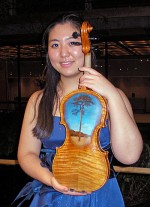Title

Alumnae Erika Mitsui (violin) and Eunice Kim (piano) perform at the Japan Society on the second anniversary of the Japanese earthquake and tsunami.
(Photo by Ayumi Sakamoto)Training at Juilliard has taught me the importance of being not only a citizen of the music world, but also a responsive member of the community. On March 11, I tried to fulfill that expectation by playing in a concert called Nocturne: Re-emergence Through Music, which was dedicated to the memory of the victims of the March 11, 2011, Japanese earthquake and tsunami, which took thousands of lives and altered the lives of the survivors in the Tohoku region.
Body
In the concert, which took place at the Japan Society, I played on a violin constructed by luthier Muneyuki Nakazawa from wood collected in the disaster area in the aftermath of the earthquake and tsunami. The tsunami swept away whole villages, houses, and signs of everyday life before the disaster. Many survivors do not have photos or objects to remind them of lost family members and friends or past memories. Two years after the tragedy, Japan has entered a reconstruction phase in which the areas hit by the disaster are rebuilding and the survivors are trying to move forward in their lives. The violin represents this bridge between the life before and after the earthquake and tsunami. The wood, previously driftwood and beams in houses, has been given a second life in the form of the violin.
Nakazawa personally went to the disaster area to collect the wood from the tsunami debris. On the back of the violin there is an image of a single pine tree. When the tsunami swept away the village of Rikuzentakata, it also swept away all but one pine tree from the area’s renowned pine forest. That pine is the one depicted on the violin, and it is a symbol for this generation and future generations to remember the disaster. Nakazawa’s goal is to have 1,000 people perform on the violin to preserve the memory of the earthquake and tsunami, a relay that started with Ivry Gitlis in Japan on the first anniversary of the disaster. I was the 119th violinist to perform on it—and five weeks later, 18 more had. By playing on this violin, performers breathe life into the past memories of the life before the disaster in the form of music. One truly remarkable aspect of music is that it is a universal language that can be understood by everyone around the world.
“This isn’t a violin meant to play big concertos in a large concert hall. That should be left to other violins,” Nakazawa said last year in an interview with the Wall Street Journal blog Japan Realtime. “I wanted to make a tender sounding violin that consoles people. This is a violin for the people in the disaster zones, for people who have grieved over lost loved ones and for the souls of those who died from this tragedy.”
I had the opportunity to work with the violin a few days before the concert. Each instrument has its own sound and personality, and the moment I started working with this one, I was struck by its very unique and sweet sound. My program was Bach’s Air, Elgar’s Salut d’Amour, Prokofiev’s Sonata No. 1 in F Minor, and the Tchaikovsky Waltz Scherzo. My mission was to deliver the voices of Tohoku to the audiences in hopes that this tragedy will not be forgotten. It was a privilege and an honor to be able to join the relay.





